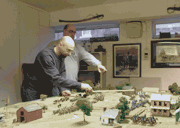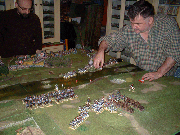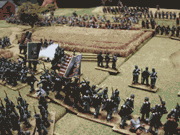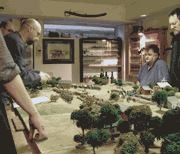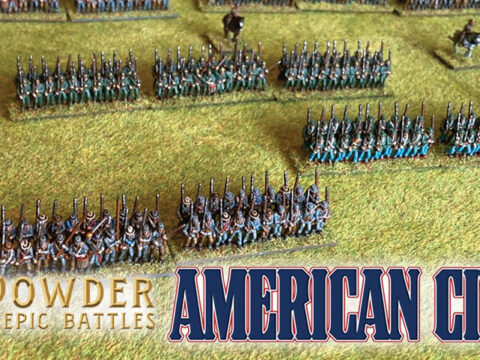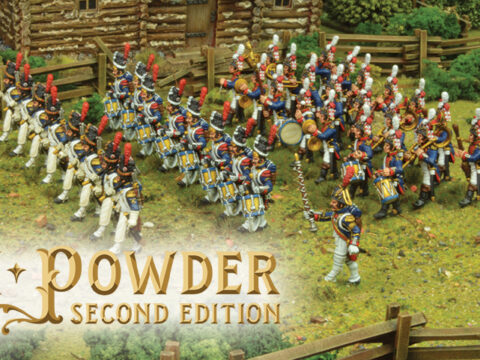BLACK POWDER!
Rules for the era 1700-1900
An introduction by Rick Priestley
‘Black Powder’ is a game that Jervis Johnson and I, together with a group of people including Warlord Games’ John Stallard and Michael and Alan Perry, have been working on and playing for four or five years. Now, I’m pleased to say that John has taken the brave step of offering to take on Black Powder as the first of his Warlord Games publications – and, of course, Jervis and I were only too happy to accept! So, what is Black Powder and what makes it different from the myriad sets of wargames rules already available and covering roughly the same era? I hope to answer that question in the course of these notes – and who knows – perhaps I’ll tempt a few readers to join our band of enthusiasts along the way.
Our game started life in the capable and preternaturally strong hands of Jervis Johnson – a man whose ape-like arms have often proven so capable when it comes to reaching the centre of a tabletop battlefield. Jervis was interested in finding ways of applying the dice driven movement system from my Warmaster game and adapting it to use with the Perry’s collections of 28mm armies – most notably their large and impressive armies of American War of Independence and Napoleonics, but with half a mind on Indian Mutiny, Crimea, the Franco-Prussian war, Zulu wars, the Sudan and other 19th Century conflicts. With appropriate rules for differing circumstances the game has since served to refight battles from approximately the years 1700 to 1900 – roughly speaking equating to the effective use of black powder weapons – and hence the name of the game!
Jervis initially ran a number of highly enjoyable AWI games on Alan Perry’s 6’ x 12’ table (remember those arms). Our early battles were highly improvised affairs with Jervis umpiring and making decisions as required, but gradually precedents were established and it was realised we had the core of a very enjoyable and unusual game. At this stage neither Jervis nor I were really sure whether our game was something that could be published – it was just too decidedly… well not to put too fine a point on it… Odd.
Odd is perhaps the wrong word. Old fashioned might be more accurate. But then again the game mechanics of Black Powder aren’t old fashioned at all – for example, the game has a fluid movement system and slightly abstracted ground and time scales that are decidedly modern developments in the history of wargaming. Conversely, the game rules make no attempt to address strictly competitive play – concentrating instead on a strongly narrative game much in the style of early wargames of the 60’s. Nor does Black Powder worry to provide army lists – the authors taking the view that anyone who has taken the trouble to collect and paint hundreds of model soldiers probably had the foresight to figure out what historical army he was attempting to represent beforehand. In short, the Black Powder game is a blend of a very old fashioned style of gaming and innovative modern mechanics. I know it won’t appeal to everyone – nor is it intended to do so – it certainly won’t appeal to hard-nosed competitive players because it’s far too consensual. I mean to say – the game doesn’t even have points values for different kinds of units or any formal rules for setting-up the game– taking the tack that such things should be a matter of scholarly agreement rather than petty legislation. See I told you Black Powder was a bit odd… I did say Black Powder was odd didn’t I?
Hopefully the preceding paragraphs with have frightened off those of an overly delicate disposition – I’m afraid Black Powder demands both robustness of mind and generosity of spirit of its players – there is no sense in pretending otherwise. That said let us take a look at some of the concepts behind the game and underlying mechanics. The first thing to be said is that the game has been written for fairly large forces and is intended to be played on a table of a good size – our own tables being six feet wide and from eight to twelve feet in length. Because we always play as a group of four or more, the game is designed to take account of co-operative play with multiple participants on each side – it works tolerably well with a single player per side but it works better as a social game. The rules of the game are intended to accommodate our collections of 28mm models based to varying standards and of admittedly inconsistent size – but generally speaking about 30 models strong for infantry and about half that for cavalry. I say all this now because I want to make it clear that the Black Powder game is a ‘toy soldiers first’ type of game – we have tailored our rules of play to suit our collections of models. The object of the game rules is to allow us to utilise our armies. Let us not imagine for a moment that the armies are mere tokens in a game –quite the contrary – the game is merely a means for us to bring our armies to life!
As already mentioned movement is dice driven – and anyone who has played Warmaster will have an idea of what that entails. It means troops move a varying distance at a time depending upon dice rolls rather than moving a predictable fixed distance each turn. This represents the fickle nature of warfare as well as a large element of surprise caused by the inability of commanders to understand what is happening beyond their immediate position on the ground. In the Black Powder game movement works like this: the player first states his intention to move a unit and must state aloud where he wishes it to move to and by what route – if he wishes to change formation he must say so and if he wishes to engage the enemy he must also say so. The player then makes a dice test and, depending on the result, his unit will move not at all, or if may move once, twice or three times in accordance with the player’s stated instructions. Regardless of how many moves a unit has it will always try to obey its instructions – so a unit ordered to charge an enemy can quite easily end up an inch or two in front of his opponent’s cannons if he fails to move quite far enough!
This movement mechanic is the basis for all manoeuvres and can lead to vast sweeping moves – especially by cavalry who have a basic 18” move distance and can therefore potentially cover 54” in a single turn of the game (3 moves). Inexperienced players often get a bit carried away by all this only to discover their troops scattered all over the battlefield and their army slowly dissolving in front of their enemy’s more solid and well-supported line. There are, of course, refinements to the system described – armies are organised into Brigades and assigned to the care of specific commanders able to order whole blocks of troops at once, troops are allowed to act on their own initiative to some extent, and occasionally troops will disregard whatever orders they are given and move seemingly at random. Because dice are used to determine movement, pure chance can sometimes hold up part of an army for several turns – making it impossible to be sure exactly where troops may be at any time.
The diced movement system lies at the core of the game and gives it its essential character. The rules for shooting and combat are not especially complex – nor are the rules especially complicated in overall terms. Once again this simply reflects the general desire of those concerned to begin and complete a fairly large battle in a single evening with plenty of drama and a satisfying conclusion. The core rules are therefore fairly breezy – although additional details can be appended to modify the course of play depending upon either the scenario or details of historical equipment and tactics.
Models are not removed to represent casualties – instead units taking ‘hits’ from shooting or combat have casualty markers assigned to them – usually up to a maximum of 3 although some units have more and some fewer. Casualty markers don’t represent literal casualties but a unit’s state of battleworthyness – as such casualties represent actual men killed or wounded, expenditure of munitions, fatigue and morale status. Units that have suffered their full quota of hits are considered ‘shaken’ and must take a break test if they suffer further hits, if other units break, and in other critical situations. Shaken units can continue to fight after a fashion, but suffer penalties to their shooting and combat, and are forbidden from engaging the enemy in hand-to-hand fighting. They may sometimes be obliged to retreat as a result of a break test – or, more dramatically, they can be broken and driven from the field in which case the whole unit is removed. This is the basic mechanic for handling unit status – and the key to winning a battle is to either break enemy troops or reduce such a large portion of the opposing army to shaken status that the whole army is obliged to withdraw.
The core rules can easily be tailored to suit varying levels of complexity as well as different historic armies. Although it would be our habit to do this in a fairly informal manner – often varying rules from one game to the next – mindful of the demands of publication we have formalised these ideas in to a series of notes and rules describing how this can be done. Rules are therefore provided for weapons such as howitzers and rockets as well as for primitive machine guns. Rules are also provided for formations typical of certain eras such as battalion squares, mixed formations, and the large brigade squares as appeared in the Sudan. Specific rules are included to reflect the abilities and foibles of different commanders and of the unusual and specific capabilities of troops. However, the general approach is to provide examples and suggestions to cover detailed conflicts rather than hard and fast rules.
Black Powder does not contain army lists – not does it utilise points values – because we have never felt the need to include such things in our own games and don’t therefore feel the need to impose them on others. Our collections are based on actual historic armies and our games are based or inspired by actual battles or campaigns. When assigning troops to battle the thought of leaving any units on the shelf seems like a waste to us – so we simply try and arrange matters to take full advantage of all the models available. Setting up the game is therefore a matter of judgement – and if one side has fewer troops than another then it is an easy matter to compensate in other ways – or not – for it is undeniably true that few real battles were arranged beforehand by points value!
To get players started we have included five scenarios together with troop lists and the rules used for that battle. These are all actual games we have played several times – although we wouldn’t normally play a game more than once, we found it necessary to do so before writing the games up. Some of the scenarios are strongly based on actual battles – notably the Battle of El Teb which took place in the Sudan – this scenario is a refight of the actual battle and uses pretty much accurate armies – though we did relent and added a few extra Sudanese cavalry… well they’d just been painted! The Napoleonic game is loosely inspired by Corunna in that it features a retreating British army caught by a larger force of French – but it is definitely in the spirit of ‘inspired by’ rather than a refight. Returning to Victoria’s army we have a battle from the Zulu War – once again inspired by an actual incident but recast to bring this famous conflict on to the wargames table. Our Crimean battle is a straight-forward encounter – just to show that the game can be used for a line-em-up-and-go battle – and we were lucky enough to have Dave Andrews’ impressive collection to fight the battle. Our final game is still to be fought at the time of writing – we might revisit one of our AWI games, although the ’45 is tempting and we also have two unbloodied Seven Years War armies eager for a try out.
Before I sign off I’ll just deal with the inevitable questions. Bases sizes – largely irrelevant – some of our models are based to 15mm frontage per man and some 20mm – so long as units are roughly the same size it doesn’t much matter. Different sized models – I guess – I have dabbled with 10mm using cm rather than inches – but the character of the game suits the larger scales (Aly Morrison has promised to debut his 40mm Shiny Toy Soldier army sometime soon!). Supplements – possibly – but we make no promises although more battle scenarios and campaigns would be tempting.

